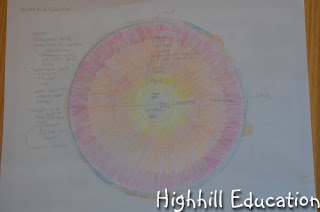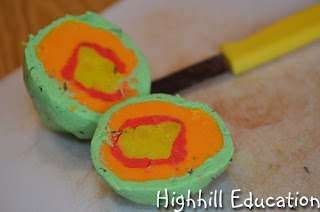How to Dig a Hole to the Other Side of the World
The Magic School Bus Inside the Earth (Magic School Bus)
Beginning with the birth of a hurricane, the film Earth from Space covers many Earth science topics we plan to revisit throughout our unit study. Off the coast of Antarctica, when the ice freezes, saltwater sinks rapidly to the bottom of the ocean creating currents which help to regulate the Earth's temperature. Hurricanes actually drop the temperature of the ocean by releasing heat into the atmosphere. Everything is connected and the common thread is the Earth.

Just like an egg, our Earth is broken into layers. It is hottest at the
core in the center. Liquid magma surrounds the core in the mantle, and
although the crust varies in thickness, it is very thin in comparison to
the diameter of the Earth.
The pit of the plum was covered with a skin. This is similar to the way the core is broken into an inner and outer core.
Here is a cross section of the Earth showing the different layers. This drawing was made by me so the kids could see the relative thickness of each layer. The dark ring around the outside is the crust. The red and orange show the mantle changes a bit with depth, and the yellow and white in the center are the inner and outer core.
The salt, water, spices and oil were added to the crust to represent rocks, coal, gold, diamonds or animal bones that may be found in the thin layer.
Once the models were complete, they were sliced open so the layers could be seen. This model shows the inner core - yellow, outer core - red, mantle orange, and crust - green.
More of our hands-on science activities are available on our Science Page.

This post is linked to:
Tried it Tuesday
* I did not receive any compensation for this recommendation. I'm just a homeschooling mom who has found many products that I like. If you're interested in the products I recommend on this blog I want to make it easy for you to find them.
** I am an Amazon associate and receive a small portion of the sales on orders made after clicking in from this site, which I promptly spend on homeschooling books and supplies for my children.









t love this topic. I like that book, too. We made our model with ice cream.
ReplyDeleteWe enjoyed making plasticene Earth models but I didn't know until now that the Earth's core was star shaped - thank you! Your youngest looks so beautiful in that photo.
ReplyDeleteOh I don't think the Earth's core is star shaped. I was referring to the apple's core. They both have varying thicknesses of layers. Sorry if I caused some confusion.
DeleteNo, now I go back and read it again it was just me being dopey. I discover so many weird and wonderful facts on this homeschooling journey that nothing surprises me these days - even the Earth's core being star shaped! Glad to have my facts straight now though. ;-) (And that I won't have to get my kids to re-make their plasticene models...)
DeleteWonderful post -- there are so many fun things to try when making models of the earth. Thanks so much for linking up at After School!
ReplyDelete